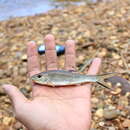en
names in breadcrumbs


The sucker barb (Barbichthys laevis) is a species of cyprinid found in Southeast Asia.[2] It is the only recognized member of its genus. In Pahang, Peninsular Malaysia, it was named Bentulu or Batu Hulu.
 Barbichthys laevis
Barbichthys laevis The sucker barb (Barbichthys laevis) is a species of cyprinid found in Southeast Asia. It is the only recognized member of its genus. In Pahang, Peninsular Malaysia, it was named Bentulu or Batu Hulu.